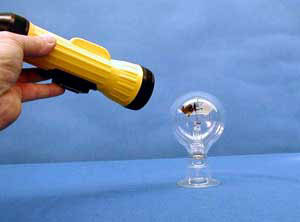Demos: 3D-02 Radiometer

In this popular toy, visible radiation is shone on the vanes, the sides of which are painted black and white, respectively. The vanes rotate with the white faces “leading.” This is the opposite to what would be expected if the motion resulted from photon impact.
The explanation is that the bulb is not a vacuum, rather air is only partially pumped out. The black faces on the vanes get hotter than the white faces. This causes the air near these vanes to get hotter, which means a greater average speed of the molecules. The collisions with the black vane surfaces transfer more momentum to these vanes, resulting in the observed direction of spin.
Directions: You can use a bright flashlight or the beam from a lantern. Although there is ambient light in the room, the friction in the “bearing” is such that only an auxiliary brighter light will set the device spinning. Hold the light close to the radiometer and it should begin spinning.
Suggestions for Presentation: As a diversion, you might indicate that light is made up of photons, so that if you shine the light on the vanes, more momentum is transferred on the white sides because of the reflection. Then show them that just the opposite occurs. How do you reconcile this?
Note: The momentum transfer by photons is extremely small. Even if there were a good vacuum in the bulb, this momentum transfer would be too small to overcome the friction in the support bearing.
Last Updated: Nov 30, 2023 11:25 AM